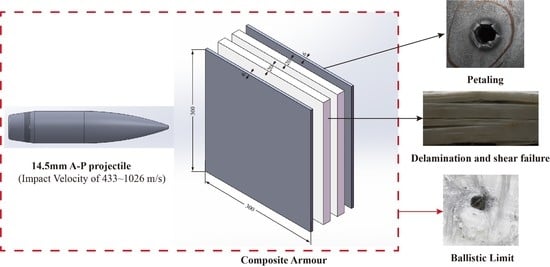Ballistic Limit of UHMWPE Composite Armor under Impact of Ogive-Nose Projectile
Abstract
1. Introduction
2. Configuration of the Armor and Projectile
2.1. Design of the Armor
2.2. Structure of the Projectile
3. Experimental Details and Results
3.1. Design of the Experiment
3.2. Experimental Results
4. Numerical Simulation and Analysis
4.1. Setup of Numerical Model
4.2. Numerical Results and Analysis
4.3. Perforation Models and Analysis
- (1)
- Principle of energy conservation
- (2)
- Lambert–Jonas model
- (3)
- Cavity–Expansion Model
5. Conclusions
Author Contributions
Funding
Institutional Review Board Statement
Data Availability Statement
Conflicts of Interest
References
- Ramadhan, A.; Talib, A.A.; Rafie, A.M.; Zahari, R. High velocity impact response of Kevlar-29/epoxy and 6061-T6 aluminum laminated panels. Mater. Des. 2013, 43, 307–321. [Google Scholar] [CrossRef]
- Supian, A.; Sapuan, S.; Jawaid, M.; Zuhri, M.; Ilyas, R.; Syamsir, A. Crashworthiness response of filament wound kenaf/glass fibre-reinforced epoxy composite tubes with influence of stacking sequence under intermediate-velocity impact load. Fibers Polym. 2022, 23, 222–233. [Google Scholar] [CrossRef]
- Aisyah, H.; Paridah, M.; Sapuan, S.; Ilyas, R.; Khalina, A.; Nurazzi, N.; Lee, S.; Lee, C. A comprehensive review on advanced sustainable woven natural fibre polymer composites. Polymers 2021, 13, 471. [Google Scholar] [CrossRef]
- Suriani, M.; Rapi, H.Z.; Ilyas, R.; Petrů, M.; Sapuan, S. Delamination and manufacturing defects in natural fiber-reinforced hybrid composite: A review. Polymers 2021, 13, 1323. [Google Scholar] [CrossRef] [PubMed]
- Nurazzi, N.; Asyraf, M.; Khalina, A.; Abdullah, N.; Aisyah, H.; Rafiqah, S.A.; Sabaruddin, F.; Kamarudin, S.; Norrrahim, M.; Ilyas, R. A review on natural fiber reinforced polymer composite for bullet proof and ballistic applications. Polymers 2021, 13, 646. [Google Scholar] [CrossRef] [PubMed]
- Pereira, A.C.; de Assis, F.S.; da Costa Garcia Filho, F.; Oliveira, M.S.; da Cruz Demosthenes, L.C.; Lopera, H.A.C.; Monteiro, S.N. Ballistic performance of multilayered armor with intermediate polyester composite reinforced with fique natural fabric and fibers. J. Mater. Res. Technol. 2019, 8, 4221–4226. [Google Scholar] [CrossRef]
- Phoenix, S.L.; Porwal, P.K. A new membrane model for the ballistic impact response and V50 performance of multi-ply fibrous systems. Int. J. Solids Struct. 2003, 40, 6723–6765. [Google Scholar] [CrossRef]
- Mei, Z.; Zhu, X.; Zhang, L. Ballistic protective mechanism of FRC laminates. Acta Mater. Compos. Sin. 2006, 23, 143–149. [Google Scholar]
- Chen, C.; Zhu, X.; Wang, J.; Hou, H.; Tang, T. Mechanism of high-velocity blunt-nosed projectiles penetrating moderately thick UHMWPE fiber reinforced plastic laminate. Acta Mater. Compos. Sin. 2013, 30, 10. [Google Scholar]
- Laessig, T.; Long, N.; May, M.; Riedel, W.; Heisserer, U.; Werff, H.; Hiermaier, S. A non-linear orthotropic hydrocode model for ultra-high molecular weight polyethylene in impact simulations. Int. J. Impact Eng. 2015, 75, 110–122. [Google Scholar] [CrossRef]
- Long, H.N.; Ryan, S.; Cimpoeru, S.J.; Mouritz, A.P.; Orifici, A.C. The effect of target thickness on the ballistic performance of ultra high molecular weight polyethylene composite. Int. J. Impact Eng. 2015, 75, 174–183. [Google Scholar]
- Nguyen, L.H.; Lassig, T.R.; Ryan, S.; Riedel, W.; Mouritz, A.P.; Orifici, A.C. Numerical Modelling of Ultra-High Molecular Weight Polyethylene Composite under Impact Loading. Procedia Eng. 2015, 103, 436–443. [Google Scholar] [CrossRef]
- Nguyen, L.H.; Ryan, S.; Cimpoeru, S.J.; Mouritz, A.P.; Orifici, A.C. The Efficiency of Ultra-High Molecular Weight Polyethylene Composite Against Fragment Impact. Exp. Mech. 2016, 56, 595–605. [Google Scholar] [CrossRef]
- Nguyen Long, H.; Laessig Torsten, R.; Shannon, R.; Werner, R.; Mouritz Adrian, P. A methodology for hydrocode analysis of ultra-high molecular weight polyethylene composite under ballistic impact. Compos. Part A 2016, 84, 224–235. [Google Scholar] [CrossRef]
- Chen, Z.; Xu, Y.; Li, M.; Li, B.; Song, W.; Xiao, L.; Cheng, Y.; Jia, S. Investigation on Residual Strength and Failure Mechanism of the Ceramic/UHMWPE Armors after Ballistic Tests. Materials 2022, 15, 901. [Google Scholar] [CrossRef]
- Yuansheng, C.; Jieke, X.; Zhe, L.; Jun, L.; Pan, Z. Damage Response Characteristics of UHMWPE/aluminum Foam Composite Sandwich Panel Subjected to CombinedBlast and Fragment Loadings. Acta Armamentarii 2021, 42, 1753. [Google Scholar]
- Hu, P.; Cheng, Y.; Zhang, P.; Liu, J.; Yang, H.; Chen, J. A metal/UHMWPE/SiC multi-layered composite armor against ballistic impact of flat-nosed projectile. Ceram. Int. 2021, 47, 22497–22513. [Google Scholar] [CrossRef]
- Yu, Z.; Li, G.; Fan, Q.; Wang, Y.; Xuan, X. Study on protection mechanism of 30CrMnMo-UHMWPE composite armor. Materials 2017, 10, 405. [Google Scholar]
- Ding, L.; Gu, X.; Shen, P.; Kong, X.; Zhou, Y. Dynamic Response of UHMW-PE Composite Armors under Ballistic Impact of Blunt Projectiles. Materials 2022, 15, 5594. [Google Scholar] [CrossRef]
- Zochowski, P.; Bajkowski, M.; Grygoruk, R.; Magier, M.; Burian, W.; Pyka, D.; Bocian, M.; Jamroziak, K. Comparison of Numerical Simulation Techniques of Ballistic Ceramics under Projectile Impact Conditions. Materials 2022, 15, 18. [Google Scholar] [CrossRef]
- Zochowski, P.; Bajkowski, M.; Grygoruk, R.; Magier, M.; Burian, W.; Pyka, D.; Bocian, M.; Jamroziak, K. Ballistic Impact Resistance of Bulletproof Vest Inserts Containing Printed Titanium Structures. Metals 2021, 11, 225. [Google Scholar] [CrossRef]
- Ammarullah, M.I.; Santoso, G.; Sugiharto, S.; Supriyono, T.; Wibowo, D.B.; Kurdi, O.; Tauviqirrahman, M.; Jamari, J. Minimizing Risk of Failure from Ceramic-on-Ceramic Total Hip Prosthesis by Selecting Ceramic Materials Based on Tresca Stress. Sustainability 2022, 14, 13413. [Google Scholar] [CrossRef]
- Børvik, T.; Forrestal, M.J.; Warren, T.L. Perforation of 5083-H116 Aluminum Armor Plates with Ogive-Nose Rods and 7.62 mm APM2 Bullets. Exp. Mech. 2010, 50, 969–978. [Google Scholar] [CrossRef]
- Forrestal, M.J.; Børvik, T.; Warren, T.L. Perforation of 7075-T651 Aluminum Armor Plates with 7.62 mm APM2 Bullets. Exp. Mech. 2010, 50, 1245–1251. [Google Scholar] [CrossRef]
- Forrestal, M.J.; Warren, T.L.; Børvik, T.; Chen, W. Perforation of 6082-T651 Aluminum Plates with 7.62 mm APM2 Bullets at Normal and Oblique Impacts; Springer International Publishing: Berlin/Heidelberg, Germany, 2015. [Google Scholar]
- Carlucci, D.E.; Jacobson, S.S. Ballistics: Theory and Design of Guns and Ammunition; CRC Press: Boca Raton, FL, USA, 2007. [Google Scholar]
- Andre, M.M. Dynamic Behavior of Materials; John Wiley & Sons: Hoboken, NJ, USA, 1994. [Google Scholar]
- Johnson, G.R.; Cook, W.H. A constitutive model and data for metals subjected to large strains, high strain-rates and high temperatures. In Proceedings of the Seventh International Symposium on Ballistics, Hague, The Netherlands, 19–21 April 1983; p. 541. [Google Scholar]
- Johnson, G.R.; Cook, W.H. Fracture characteristics of three metals subjected to various strains, strain rates, temperatures, and pressres. Eng. Fract. Mech. 1985, 21, 31–48. [Google Scholar] [CrossRef]
- Lambert, J.P.; Jonas, G.H. Towards Standardization in Terminal Ballistics Testing: Velocity Representation; Defence Technical Information Center: Fort Belvoir, VA, USA, 1976. [Google Scholar]
- Zukas, J.A. High Velocity Impact Dynamics; Wiley-Interscience: Hoboken, NJ, USA, 1990. [Google Scholar]
- Hazell, P.J. Armour: Materials, Theory, and Design; CRC Press: Boca Raton, FL, USA, 2015. [Google Scholar]
- Recht, R.F.; Ipson, T.W. Ballistic Perforation Dynamics. J. Appl. Mech. 1963, 30, 384. [Google Scholar] [CrossRef]
- Forrestal, M.J.; Warren, T.L. Perforation equations for conical and ogival nose rigid projectiles into aluminum target plates. Int. J. Impact Eng. 2009, 36, 220–225. [Google Scholar] [CrossRef]
- Piekutowski, A.; Forrestal, M.; Poormon, K.; Warren, T. Perforation of aluminum plates with ogive-nose steel rods at normal and oblique impacts. Int. J. Impact Eng. 1996, 18, 877–887. [Google Scholar] [CrossRef]
- Forrestal, M.; Warren, T. Brief Technical Note Perforation of Steel Plates with 7.62 mm APM2 Bullets. J. Dyn. Behav. Mater. 2022, 8, 418–421. [Google Scholar] [CrossRef]
- Taylor, G. The formation and enlargement of a circular hole in a thin plastic sheet. Q. J. Mech. Appl. Math. 1948, 1, 103–124. [Google Scholar] [CrossRef]
- Rosenberg, Z.; Dekel, E. Terminal Ballistics; Springer: Berlin/Heidelberg, Germany, 2012. [Google Scholar]



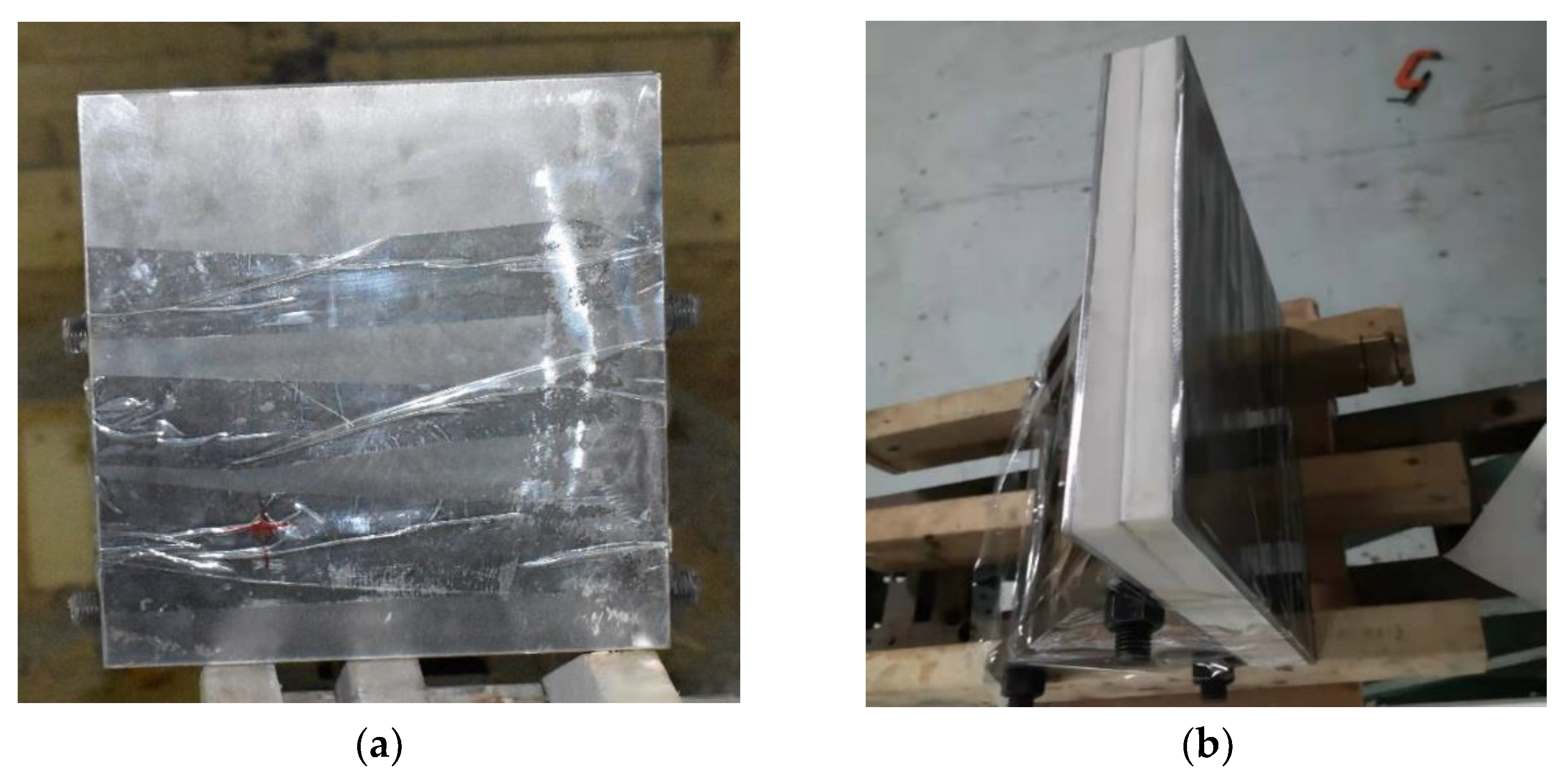




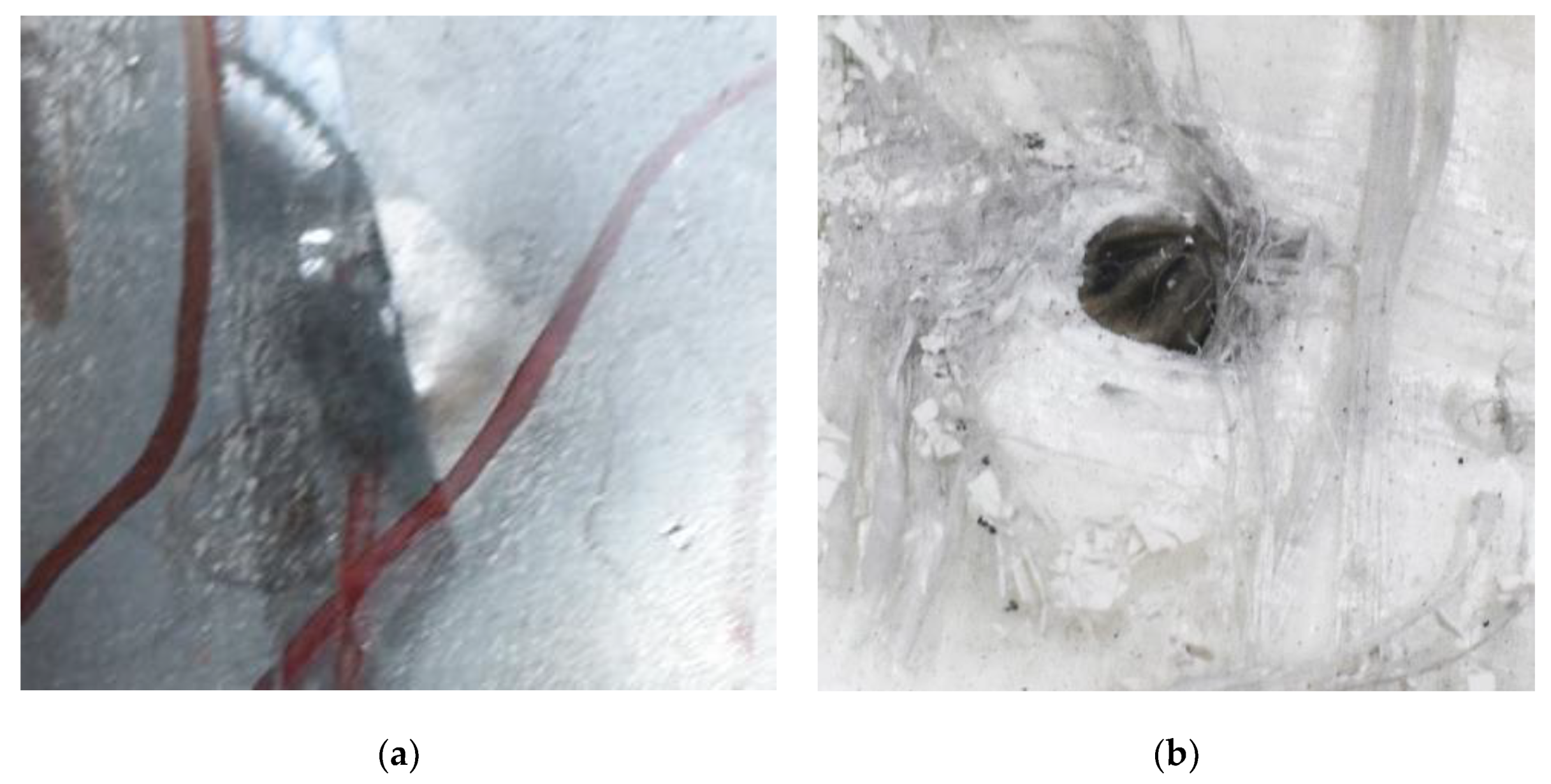




| Steel | Yield Strength (MPa) | Tensile Strength (MPa) | Elongation after Break (%) | Poisson’s Ratio (%) | Impact Energy Aku (J) |
|---|---|---|---|---|---|
| Q235 | 305 | 426 | 30 | 0.33 | ≥27 |
| vi (m/s) | Perforation State in the Front and Back | |
|---|---|---|
| 1026.1 | 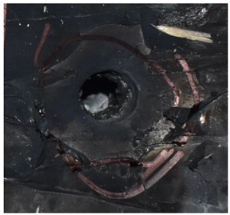 | 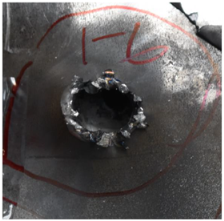 |
| 966.6 |  |  |
| 768.7 |  |  |
| 688.4 |  |  |
| 616.8 | 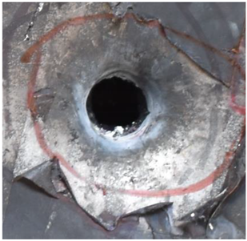 |  |
| 595.4 |  | 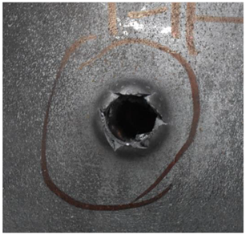 |
| 524.8 |  | 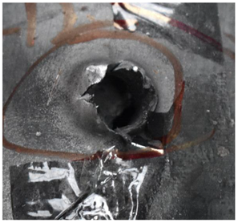 |
| 501.1 | 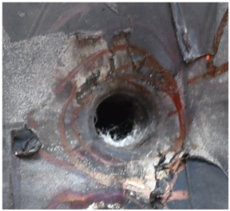 |  |
| 433.3 |  |  |
| Components | Material | ρ (g/cm3) | Equation of State | Constitutive Model |
|---|---|---|---|---|
| Penetrator | Steel S-7 | 7.83 | Shock | Johonson-Cook |
| Face sheet | Steel Q235 | 7.896 | Shock | Johonson-Cook |
| PE laminates | UHMWPE | 0.98 | Ortho | Orthotropic Yield |
| Material | Grüneisen Coefficient | C (m/s) | S1 | S2 | a |
|---|---|---|---|---|---|
| S-7 | 2.17 | 4569 | 1.330 | 0 | 0.47 |
| Q235 | 2.17 | 4569 | 1.490 | 0 | 0.46 |
| Steel | ρ (g/cm3) | A (MPa) | B (MPa) | n | C | m | Tr (K) | Tm (K) | |
|---|---|---|---|---|---|---|---|---|---|
| S-7 | 7.850 | 1540 | 477 | 0.16 | 0.016 | 1.0 | 1 | 293 | 1763 |
| Q235 | 7.896 | 350 | 275 | 0.36 | 0.022 | 1.0 | 1 | 293 | 1793 |
| Value | Units | Parameters | Value | Units | |
|---|---|---|---|---|---|
| Reference density | 0.98 | g/cm3 | Shear modulus 12 | 2.0 × 106 | kPa |
| Young’s modulus 11 | 3.62 × 106 | kPa | Shear modulus 23 | 1.92 × 105 | kPa |
| Young’s modulus 22 | 5.11 × 107 | kPa | Shear modulus 31 | 2.0 × 106 | kPa |
| Young’s modulus 33 | 5.11 × 107 | kPa | Volumetric response: shock Grüneisen coefficient | 1.64 | - |
| Poisson’s ratio 12 | 0.013 | - | Parameter C1 | 3.57 × 103 | m/s |
| Poisson’s ratio 31 | 0.5 | - | Parameter S1 | 1.3 | - |
| Reference temperature | 293 | K | Specific heat | 1.85 × 103 | J/kgK |
| Parameters | Value | Units | Parameters | Value | Units |
|---|---|---|---|---|---|
| Plasticity constant 11 | 0.016 | - | Eff. plastic strain #1 | 0 | - |
| Plasticity constant 22 | 6 × 10−4 | - | Eff. plastic strain #2 | 0.01 | - |
| Plasticity constant 33 | 6 × 10−4 | - | Eff. plastic strain #3 | 0.1 | - |
| Plasticity constant 12 | 0 | - | Eff. plastic strain #4 | 0.15 | - |
| Plasticity constant 13 | 0 | - | Eff. plastic strain #5 | 0.175 | - |
| Plasticity constant 23 | 0 | - | Eff. plastic strain #6 | 0.19 | - |
| Plasticity constant 44 | 1 | - | Eff. plastic strain #7 | 0.2 | - |
| Plasticity constant 55 | 1.7 | - | Eff. plastic strain #8 | 0.205 | - |
| Plasticity constant 66 | 1.7 | - | Eff. plastic strain #9 | 0.21 | - |
| / | / | Eff. plastic strain #10 | 0.215 | - | |
| Eff. stress #1 | 1.48 × 103 | kPa | Eff. stress #6 | 6.0 × 104 | kPa |
| Eff. stress #2 | 7.0 × 103 | kPa | Eff. stress #7 | 8.0 × 104 | kPa |
| Eff. stress #3 | 2.7 × 104 | kPa | Eff. stress #8 | 9.8 × 104 | kPa |
| Eff. stress #4 | 4.0 × 104 | kPa | Eff. stress #9 | 2.0 × 105 | kPa |
| Eff. stress #5 | 5.0 × 104 | kPa | Eff. stress #10 | 1.0 × 106 | kPa |
| vi (m/s) | State of Perforation and Deformation | p (mm) | vi (m/s) | State of Perforation and Deformation | vr (m/s) |
|---|---|---|---|---|---|
| 430 | 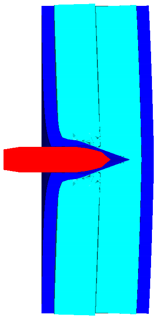 | 41.55 | 530 |  | 174 |
| 450 |  | 43.15 | 600 | 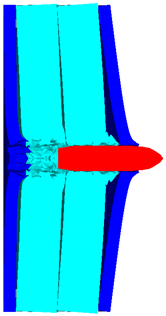 | 329 |
| 500 |  | 53 | 700 | 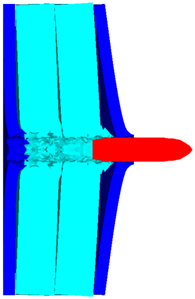 | 490 |
| vi (m/s) | 500 | 530 | 600 | 700 | 800 | 900 | 1000 |
|---|---|---|---|---|---|---|---|
| vr (m/s) | 0 | 174 | 329 | 490 | 623 | 748 | 866 |
| W (kJ) | 5.05 | 5.06 | 5.09 | 5.05 | 5.09 | 5.06 | 5.05 |
| Materials | E (GPa) | Ultimate Tensile/ Compressive Strength (MPa) | H (GPa) | σs Predicted from Equation (25) (GPa) | σs Predicted from Equation (27) (GPa) |
|---|---|---|---|---|---|
| Q235 | 200 | 305 | 281 | 2.76 | / |
| UHMWPE | 113~124 | 2700~3200 | / | / | 3.59~4.26 |
Publisher’s Note: MDPI stays neutral with regard to jurisdictional claims in published maps and institutional affiliations. |
© 2022 by the authors. Licensee MDPI, Basel, Switzerland. This article is an open access article distributed under the terms and conditions of the Creative Commons Attribution (CC BY) license (https://creativecommons.org/licenses/by/4.0/).
Share and Cite
Ding, L.; Gu, X.; Shen, P.; Kong, X. Ballistic Limit of UHMWPE Composite Armor under Impact of Ogive-Nose Projectile. Polymers 2022, 14, 4866. https://doi.org/10.3390/polym14224866
Ding L, Gu X, Shen P, Kong X. Ballistic Limit of UHMWPE Composite Armor under Impact of Ogive-Nose Projectile. Polymers. 2022; 14(22):4866. https://doi.org/10.3390/polym14224866
Chicago/Turabian StyleDing, Li, Xiaohui Gu, Peihui Shen, and Xiangsheng Kong. 2022. "Ballistic Limit of UHMWPE Composite Armor under Impact of Ogive-Nose Projectile" Polymers 14, no. 22: 4866. https://doi.org/10.3390/polym14224866
APA StyleDing, L., Gu, X., Shen, P., & Kong, X. (2022). Ballistic Limit of UHMWPE Composite Armor under Impact of Ogive-Nose Projectile. Polymers, 14(22), 4866. https://doi.org/10.3390/polym14224866










